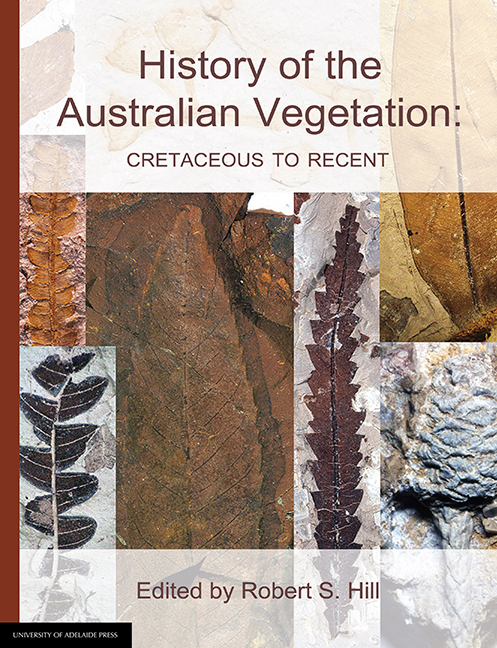Book contents
- Frontmatter
- Contents
- List of contributors
- Introduction to the 2017 edition
- 1 The Australian fossil plant record: an introduction
- 2 Maps of late Mesozoic-Cenozoic Gondwana break-up: some palaeogeographical implications
- 3 The background: 144 million years of Australian palaeoclimate and palaeogeography
- 4 Palaeobotanical evidence for Tertiary climates
- 5 Landscapes of Australia: their nature and evolution
- 6 Patterns in the history of Australia's mammals and inferences about palaeohabitats
- 7 Australian Tertiary phytogeography: evidence from palynology
- 8 Cretaceous vegetation: the microfossil record
- 9 Cretaceous vegetation: the macrofossil record
- 10 Early Tertiary vegetation: evidence from spores and pollen
- 11 The early Tertiary macrofloras of continental Australia
- 12 Cenozoic vegetation in Tasmania: macrofossil evidence
- 13 The Neogene: a period of transition
- 14 The Oligo-Miocene coal floras of southeastern Australia
- 15 Quaternary vegetation
- 16 The history of selected Australian taxa
- Taxonomic index
- General index
11 - The early Tertiary macrofloras of continental Australia
Published online by Cambridge University Press: 25 July 2017
- Frontmatter
- Contents
- List of contributors
- Introduction to the 2017 edition
- 1 The Australian fossil plant record: an introduction
- 2 Maps of late Mesozoic-Cenozoic Gondwana break-up: some palaeogeographical implications
- 3 The background: 144 million years of Australian palaeoclimate and palaeogeography
- 4 Palaeobotanical evidence for Tertiary climates
- 5 Landscapes of Australia: their nature and evolution
- 6 Patterns in the history of Australia's mammals and inferences about palaeohabitats
- 7 Australian Tertiary phytogeography: evidence from palynology
- 8 Cretaceous vegetation: the microfossil record
- 9 Cretaceous vegetation: the macrofossil record
- 10 Early Tertiary vegetation: evidence from spores and pollen
- 11 The early Tertiary macrofloras of continental Australia
- 12 Cenozoic vegetation in Tasmania: macrofossil evidence
- 13 The Neogene: a period of transition
- 14 The Oligo-Miocene coal floras of southeastern Australia
- 15 Quaternary vegetation
- 16 The history of selected Australian taxa
- Taxonomic index
- General index
Summary
Plant macrofossil deposits have been recorded from Australia for well over 100 years. Early reports were primarily from localities in Victoria and New South Wales; these are population centres and hence excavations likely to produce fossil material were commonest in those two states. Early work included reports by von Ettingshausen (1883, 1886, 1888), Deane (1895, 1900, 1902a,b,c, 1904) and von Mueller (1874, 1883), and was generally concerned with relating the fossils to extant plants on the basis of gross morphological features. Our current knowledge of continental drift throws doubt on the suggested affinities, found in the earlier papers, of the Australian fossils with northern hemisphere plants. Even those taxa with suggested Australian affinities unfortunately cannot be confirmed, as much of the material is either no longer available or is preserved in such a manner as to render it useless (Hill, 1988b). Therefore, these older reports and their deposits are not considered in this chapter. The reader interested in following them up can consult Hill (1988b) for general references or Christophel (1992) for specific references on Victoria. The locality that is an exception is Vegetable Creek, New South Wales. Hill (1988b) has reported that a number of the fossils from the original von Ettingshausen work on this deposit are still available and are excellently preserved. This flora, considered to be Late Eocene, is particularly important, as it contains the earliest macrofossils attributable to Nothofagus from continental Australia (Hill, 1988b).
Theoretically, the scope of this chapter is the entire early Tertiary, which includes the Paleocene, Eocene and Oligocene epochs. The reality of the situation, however, is that the chapter is basically an essay on the Eocene floras of Australia - primarily the Middle Eocene of southeastern Australia. This is due solely to the fact that most of the published accounts of early Tertiary macrofossil floras from continental Australia deal with Eocene localities. Indeed, only two Paleocene and two Oligocene floras (published or under current study) are known to the author, and none of these is extensive. It is the opinion of one biostratigrapher (B. McGowran, personal communication) that continental Australia has no Early Oligocene plant fossil assemblages, and hence this period, potentially of great evolutionary import after the global terminal Eocene climatic deterioration (McGowran, 1992), may never be documented.
- Type
- Chapter
- Information
- History of the Australian VegetationCretaceous to Recent, pp. 262 - 275Publisher: The University of Adelaide PressPrint publication year: 2017



